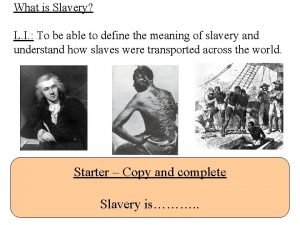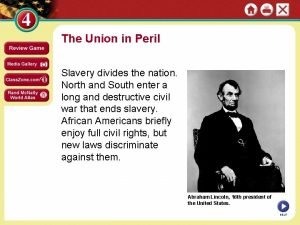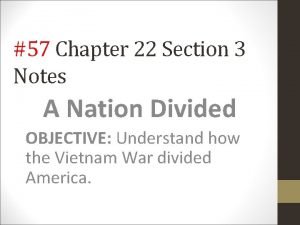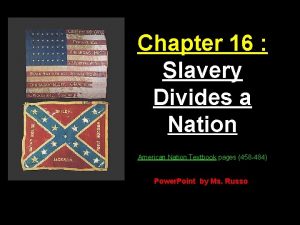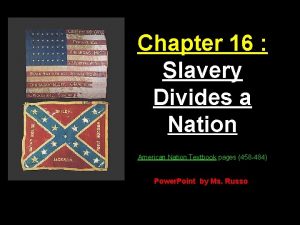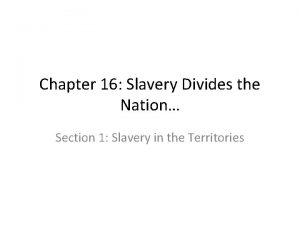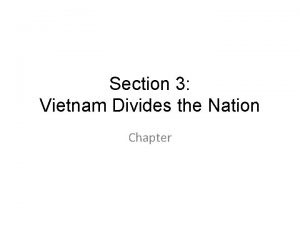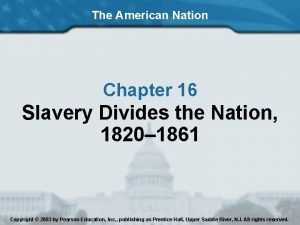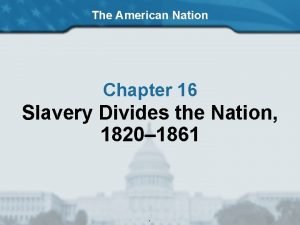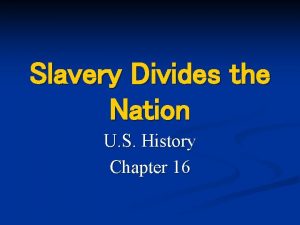Divides a Nation Chapter 7 Section 2 Key










- Slides: 10

Divides a Nation Chapter 7 Section 2 Key People SLAVERY

ABOLITIONIST MOVEMENT HARRIET BEECHER STOWE � � � Published in 1852, Uncle Tom’s Cabin tells the story of a Christian slave, Uncle Tom, who is sold by a Kentucky family burdened by debt. Finally, sold again, he dies under the lash of the henchman of a cruel overseer, Simon Legree, who wants Uncle Tom to accept him instead of God as his master. Stowe, a member of a family of prominent abolitionists and ministers, also recounts the flight of a family of runaways on the Underground Railroad. � http: //classroomclips. org/video/3135 � http: //video. pbs. org/video/2295592489 /

ABOLITIONIST MOVEMENT - JOHN BROWN This photograph of John Brown was taken in 1856 while the abolitionist was in Kansas, the same year he led an attack on a settlement along the Pottawatomie River in which five unarmed, proslavery settlers were seized and brutally murdered. Although Brown could have killed as many as nine men in the attack, he settled on five -the same number of antislavery men who had recently died at the hands of southern settlers. The retaliation, Brown claimed, was to create "a restraining fear" among the aggressive proslavery advocates. � John Brown was a man of action -- a man who would not be deterred from his mission of abolishing slavery. On October 16, 1859, he led 21 men on a raid of the federal arsenal at Harpers Ferry, Virginia. His plan to arm slaves with the weapons he and his men seized from the arsenal was thwarted, however, by local farmers, militiamen, and Marines led by Robert E. Lee. Within 36 hours of the attack, most of Brown's men had been killed or captured. http: //www. pbs. org/wgbh/amex/brown/m aps/map. html � � 00: 31: 00 – Bleeding Kansas http: //www. youtube. com/watch? v=XOJz SAbq. HHQ 00: 53: 00 01: 15: 00 00: 03: 48

JOHN BROWN’S RAID AT HARPERS’ FERRY ARSENAL Frank Leslie's illustrated newspaper, v. 8, no. 207 (1859 Nov. 19), p. 383. John Brown, now under sentence of death for treason and murder, at Charlestown, Va. From a photograph taken one year ago by Martin M. Lawrence, 381 Broadway, N. Y

ABOLITIONIST MOVEMENT � Fredrick Douglass – former slave who escaped & later published a newspaper – “North Star” � Traveled around the country describing the evils of slavery http: //video. pbs. org/video/2291360172/

ARGUMENT FOR SLAVERY � Charles Fitzhugh published Positive Good Thesis of Slavery � Argued slavery as an OBLIGATION of whites to feed, clothe, and provide church instruction to slaves � Southerners viewed slavery as a favor

SUPREME COURT DECISION FREE MAN OR SLAVE 1834 – a slave in Missouri � Moves to Illinois and then Wisconsin, both free states � Returns to Missouri w/ his master & claims to be free � Files a lawsuit for freedom status based on living in free states � 1857 – justices state that Scott can NOT SUE because he is a slave & SLAVES are NOT CITIZENS. � CASE causes further DIVISION http: //video. pbs. org/video/2298073069/ between North & South. �

Frank Leslie's Illustrated Newspaper, (1857 June 27), front page.

Chief Justice Roger Taney wrote the Court’s majority opinion: 1. Slaves /African Americans, could not sue in federal court because they were not recognized as U. S. citizens according to the Constitution. (What amendment finally changes this? ) 2. The National government did not have the right to exclude slavery from the territories, enslaved people were considered property and the Constitution protects the movement of property. Therefore, the due process clause of the Fifth Amendment protected property rights. So, a slaveholder had the right to own slaves anywhere in the country or its territories. (This negates the 36° 30’ line)

HOMEWORK � Who was Sojourner Truth? Read Ch 7 page 235. Write a summary paragraph answering: who? What? Where? When? How? Why? Martians need to know.
 Slavery meaning
Slavery meaning Slavery divides the nation
Slavery divides the nation Slavery divides the nation
Slavery divides the nation Chapter 16 section 1 rebuilding the nation answer key
Chapter 16 section 1 rebuilding the nation answer key Example of nation
Example of nation Nation vs state
Nation vs state State vs nation
State vs nation Concept mapping chapter 10 meiosis 1 and meiosis 2
Concept mapping chapter 10 meiosis 1 and meiosis 2 Chapter 6 section 2 foreign affairs trouble the nation
Chapter 6 section 2 foreign affairs trouble the nation Chapter 22 section 3 a nation divided
Chapter 22 section 3 a nation divided Chapter 22 section 1 the nations sick economy
Chapter 22 section 1 the nations sick economy
